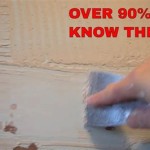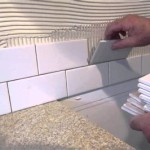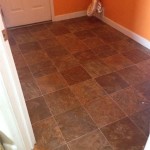Can You Tile Over Concrete: A Comprehensive Guide
The question of whether tile can be installed over concrete is a common one for homeowners and construction professionals alike. The short answer is yes, tiling over concrete is generally feasible, and it's a frequent practice used to enhance both the aesthetic and functional aspects of various spaces. However, the success of such an installation hinges on several critical factors relating to the condition of the concrete, the preparation involved, and the correct choice of materials and installation techniques.
Concrete provides a solid, stable subfloor for tile, which is a significant advantage. Its inherent strength and rigidity prevent excessive flexing, which can lead to cracked tiles and grout. Furthermore, concrete’s thermal mass contributes to energy efficiency, helping to regulate temperature within a building. Despite these benefits, directly adhering tile to concrete without proper assessment and preparation can lead to issues. This article will delve into the essential considerations for a successful tile-over-concrete installation.
Key Point 1: Assessing the Concrete Subfloor
Before commencing any tiling project, a thorough examination of the concrete subfloor is paramount. This involves evaluating various parameters to ensure the concrete is suitable for tile installation. The condition of the concrete directly impacts the long-term integrity and appearance of the tiled surface. Key elements to assess include moisture levels, flatness (or levelness), structural soundness, and the presence of any contaminants or existing coatings.
Moisture Content:
Excess moisture is a primary enemy of both tile and the adhesives used to bond them to the concrete. High moisture levels can lead to the adhesive breaking down over time, resulting in loose or cracked tiles. Moreover, trapped moisture can promote the growth of mold and mildew, creating an unhealthy environment. A concrete moisture meter is crucial for accurately measuring moisture content. Acceptable levels typically vary depending on the type of adhesive and tile being used, but generally, the moisture content should be within the manufacturer's recommended specifications. If moisture levels are high, remedial measures such as applying a moisture barrier may be necessary before proceeding.Flatness and Levelness:
The ideal concrete subfloor should be reasonably flat and level. Significant deviations or unevenness can create challenges during tile installation, requiring excessive use of thin-set mortar to compensate for irregularities. This can lead to weak spots and inconsistent tile heights, ultimately compromising the finished appearance. A long, straight edge or a laser level can be used to identify high and low spots. Minor imperfections can often be corrected using self-leveling compounds. However, significant variations may require grinding or patching to achieve a suitable surface.Structural Soundness:
The concrete slab must be structurally sound and free from cracks or excessive settling. Cracks, particularly those wider than hairline fractures, indicate potential structural problems that could compromise the tile installation. Active cracks, which continue to widen or shift over time, require professional evaluation and repair before any tiling work can commence. Hairline cracks can often be mitigated with the use of crack isolation membranes, which are designed to prevent movement in the concrete from transferring to the tiles.Contaminants and Coatings:
Any existing coatings, sealers, paints, or adhesives must be thoroughly removed from the concrete surface. These substances can interfere with the bond between the concrete and the tile adhesive, causing premature failure. Furthermore, contaminants such as oil, grease, or dust can also impede adhesion. Mechanical methods, such as grinding or sanding, are often necessary to remove these substances and create a clean, porous surface for bonding. A thorough cleaning with a suitable degreaser or cleaner is also essential to ensure optimal adhesion.Key Point 2: Surface Preparation for Tile Installation
Once the concrete subfloor has been thoroughly assessed and deemed suitable, the next critical step involves preparing the surface for tile installation. This preparation is crucial for ensuring a strong, durable bond between the tile and the concrete. Improper preparation is a common cause of tile failure, resulting in costly repairs and aesthetic issues. Key preparation steps include cleaning, profiling, and applying primers or membranes as needed.
Cleaning:
As mentioned previously, thorough cleaning is essential to remove any dust, debris, or contaminants that could interfere with adhesion. Vacuuming the surface is a good initial step, followed by scrubbing with a suitable cleaner or degreaser. Pressure washing can be effective for removing stubborn dirt and grime, but it's crucial to allow the concrete to dry completely before proceeding with further preparation.Profiling:
Concrete typically has a smooth surface which is not ideal for bonding. Profiling the surface involves creating a slightly rough or textured surface that provides a mechanical key for the tile adhesive. This can be achieved through various methods, including acid etching, grinding, or scarifying. Acid etching involves applying a diluted solution of muriatic acid to the concrete surface, which etches away a thin layer of cement paste and exposes the aggregate. Grinding involves using a diamond grinding wheel to remove a thin layer of concrete and create a rough texture. Scarifying involves using a specialized machine with rotating teeth to create grooves in the concrete surface. Regardless of the method used, the goal is to create a surface profile that is conducive to strong adhesion. Proper surface profile should be confirmed by the adhesive manufacturer guidelines.Priming:
Applying a primer to the concrete surface can further enhance adhesion and prevent the adhesive from drying out too quickly. Primers typically consist of acrylic or epoxy-based formulations that penetrate the concrete pores and create a strong bond. The selection of the appropriate primer depends on the type of adhesive being used and the specific characteristics of the concrete surface. Some primers also offer added benefits, such as dust suppression and moisture resistance.Crack Isolation Membranes:
As alluded to earlier, crack isolation membranes are thin, flexible sheets or liquid-applied coatings that are designed to prevent movement in the concrete from transferring to the tiles. These membranes are particularly useful in areas where concrete is prone to cracking or movement, such as in basements or over expansion joints. Crack isolation membranes are typically applied after the concrete surface has been cleaned and primed. They provide an added layer of protection against tile cracking and delamination.Key Point 3: Selecting the Right Materials and Techniques
Choosing the appropriate materials and employing proper installation techniques are crucial for ensuring a successful and long-lasting tile-over-concrete installation. This includes selecting the right type of tile, adhesive (thin-set mortar), grout, and tools, as well as following established best practices for tile layout, cutting, and setting.
Tile Selection:
The type of tile selected should be appropriate for the intended use of the space. For example, in high-traffic areas, durable tiles such as porcelain or ceramic are generally preferred. In wet areas such as bathrooms or kitchens, tiles with a low water absorption rate are essential to prevent moisture damage. The size and shape of the tile can also impact the installation process and the overall appearance of the finished surface. Large-format tiles, for example, may require specialized installation techniques to ensure proper bonding and alignment.Adhesive (Thin-Set Mortar) Selection:
The choice of thin-set mortar is critical for achieving a strong and durable bond between the tile and the concrete. Different types of thin-set mortar are formulated for different types of tile and different environmental conditions. Modified thin-set mortars, which contain polymers that enhance adhesion and flexibility, are generally recommended for tile-over-concrete installations. It is important to select a thin-set mortar that is specifically designed for the type of tile being used and that meets or exceeds the relevant industry standards. Always follow the manufacturer's instructions carefully when mixing and applying the thin-set mortar.Grout Selection:
Grout fills the joints between the tiles and provides a finished appearance. The type of grout selected should be appropriate for the type of tile and the intended use of the space. Cement-based grouts are commonly used for general-purpose applications, while epoxy grouts offer superior stain resistance and durability, making them ideal for high-traffic areas and wet environments. Selecting the right grout color can also significantly impact the overall aesthetic of the tiled surface. Grout should be properly sealed to prevent staining and water damage.Installation Techniques:
Proper installation techniques are essential for ensuring a professional-looking and long-lasting tile installation. This includes carefully planning the tile layout, using a notched trowel to apply the thin-set mortar evenly, setting the tiles firmly into the mortar, and maintaining consistent grout lines. It is also important to use appropriate cutting tools to create clean and accurate cuts, particularly around edges and corners. Regular cleaning during the installation process is also essential to remove any excess mortar or grout and ensure a clean finished surface.How To Install Tiles On Concrete Floors Stonesuper

Tiling Over A Ed Concrete Slab Fine Homebuilding
:max_bytes(150000):strip_icc()/can-you-install-tile-directly-on-concrete-1822600-04-458f7bb6c78348c1835cf8054ef36553.jpg?strip=all)
How To Install Tile Over Concrete
How To Tile Onto Concrete Floors Porcelain Super

How To Lay A Tile Floor On Concrete Diy Homeimprovement

How To Lay Tile On Concrete With Pictures Wikihow

Tile Over Concrete Subfloor An Easy Diy Tutorial

Covering Concrete Slab Installation Dektektile Luxury Tile Decking Material

How To Lay Outdoor Tile On Concrete In New Jersey Standard

How To Install Deck Tiles Over Concrete Materials Costs More
Related Posts








